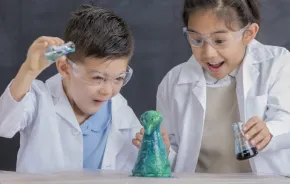
Editor’s note: In this nine-month series we explore how new voluntary standards developed in Washington state are impacting the quality of after-school programs that serve about 134,000 youths after the school bell rings. We will explain what parents should seek in a program, look at research on the impacts of quality care on kids’ development and academics and visit with programs that are successfully serving kids and helping families. After-school Special’s independently reported content is funded by a journalism grant in partnership with the Raikes Foundation and School’s Out Washington. See the full series of articles here.
I n a brightly colored exhibit hall, visitors to Seattle Art Museum’s “Indigenous Beauty” exhibition see striking works of native art. Spanning a period of 2,000 years, items include intricately beaded children’s clothing, woven Tlingit baskets and carved, colorful katsina dolls that depict spiritual beings in Hopi and Zuni cultures.
n a brightly colored exhibit hall, visitors to Seattle Art Museum’s “Indigenous Beauty” exhibition see striking works of native art. Spanning a period of 2,000 years, items include intricately beaded children’s clothing, woven Tlingit baskets and carved, colorful katsina dolls that depict spiritual beings in Hopi and Zuni cultures.
On a recent afternoon, about two dozen teenagers embark on their first tour of the exhibit. Their curiosity in the native pieces is genuine, but it’s also mission-driven: On May 8, this group of teen arts ambassadors will throw a Teen Night Out party at Seattle Art Museum (SAM) for hundreds of their peers in hopes of sparking an interest in art. These teen leaders will be docents for the evening, plan the food and drinks, organize and lead activities, such as papier-mâché mask making, and even line up top local DJs and live musical performers.
“A lot of places teach fine art. We’re about more than that; we’re also about youth development,” says Sarah Bloom, manager of SAM’s Teen, Family and Community Engagement Programs. The high school students are part of an after-school program at SAM called Teen Arts Group (TAG). As part of the curriculum, the students meet weekly all year long and plan two of these elaborate events on their own.
“We’ve seen kids who are super quiet when they start, [and] within six months they are giving a tour, giving a nuanced take on a social justice issue in an exhibit or gender roles through the works of art — it’s a great vehicle for them to see their place in the world,” Bloom says.
“I thought of myself as a leader, but I had struggled with the confidence part, which is an important part of being a leader,” says Sophia Orlando, a senior at Garfield High School in Seattle. Orlando says that since starting the program three years ago, she understands that she doesn’t need to be an art expert in order to comfortably lead peers in discussions about the meaning of the pieces and motivations of the artists. “I see that it’s really about questions, knowing how to ask something that will get them talking, and getting other people involved in seeing art from a different perspective.”
We’ve seen kids who are super quiet when they start, [and] within six months they are giving a tour, giving a nuanced take on a social justice issue in an exhibit or gender roles through the works of art — it’s a great vehicle for them to see their place in the world.
-Sarah Bloom, manager of SAM's Teen, Family and Community Engagement Programs
SAM was one of 15 organizations in King, Pierce and Spokane counties recognized last fall by the Raikes Foundation for excellence in providing out-of-school-time programs. The museum and hundreds of other organizations have invested in School’s Out Washington’s Youth Program Quality (YPQ) Initiative, a voluntary tool kit of self-evaluation and outside assessments aimed at raising the caliber of after-school programs. SAM’s teens also lead monthly art labs and, through various social media, promote art appreciation among young people.
According to the quality standards, programs can get stronger by encouraging youth leadership and engagement: They promote a sense of purpose and individual empowerment, support youth decision making, and give young people a sense of belonging and ownership. “I’ve worked four Teen Nights Out,” says 17-year-old Kaeley Pilichowski. “We are the ones that have to be creative in how we engage all kinds of other teens, recognizing that most people aren’t like yourself.”
Quality training for staff spills over into other SAM offerings, too; for instance, free weekend workshops at the Olympic Sculpture Park on Seattle’s waterfront, where, on one recent winter day, kids make recycled rainsticks out of plastic water bottles or construct cardboard boats. “Even though I’m a teaching artist, I’m more facilitator than instructor,” says YPQ-trained artist Janet Fagan. “We provide the starting point, and then leave space for things to happen, where families can work on something together.”
According to a report by the Afterschool Alliance, “At a time when arts education often loses the battle for classroom time in schools, after-school programs can offer much-needed support and provide students with an additional outlet to participate in the arts.”
Two years ago, Jo Nordhoff-Beard, a senior at University Prep, was going through a difficult time. The TAG program brought the right opportunity at just the right time. “It helped me get through some hard things, some bad things. This is a safe space, we’re all accepting of where we are, everyone feels welcome,” she says.
After May’s Teen Night Out, when hundreds of young people will have streamed through the “Indigenous Beauty” exhibit experiencing the native artifacts in ways they hadn’t before, this TAG team will be able to reflect on its achievement. “It’s huge when they see everything they’ve planned come together,” Bloom says. “It’s an extreme sense of accomplishment; there’s a lot of pride.”











